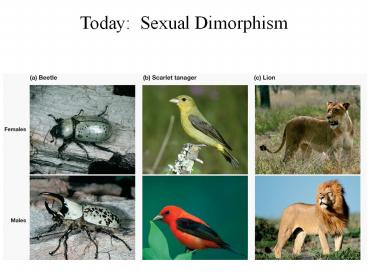Today: Sexual Dimorphism - PowerPoint PPT Presentation
Title:
Today: Sexual Dimorphism
Description:
Today: Sexual Dimorphism Different reproductive strategies lead to differences in sexual dimorphism. haploid diploid X 23 in humans X 23 in humans X 23 in humans ... – PowerPoint PPT presentation
Number of Views:98
Avg rating:3.0/5.0
Title: Today: Sexual Dimorphism
1
Today Sexual Dimorphism
2
Why does sexual reproduction exist?
- Cons
- Need two individuals
- Hard to find mate
- Diseases
- Competition
- Pros
- Genetic diversity
- or
- Replace damage DNA
3
The male perspective on reproduction
4
Eggs require large resource input. A clutch of
bird eggs can be 20 of birds weight. Sperm
are cheap.
5
A female kiwi ready to lay an egg.
From Biological Science 3rd ed. by Scott
Freeman -fig 25.13
6
Fig 46.12
Human Males 250,000,000 sperm/ ejaculation
Human Females 1 egg/month
7
I hope Pat likes my feathers because I am tired
of dragging them around everywhere.
Fig 23.15
8
1
Which is male?
2
9
1
Which is male?
2
10
Sexual Dimporphism differences between males
and females
11
Sexual Dimorphism
12
Male barn swallows have longer tails than females
13
From Biological Science 3rd ed. by Scott
Freeman -fig 51.5
Why do males have long tails?
14
(No Transcript)
15
Female grizzly bears cannot reproduce while
lactating. Therefore they can only reproduce
every once every 3 years
16
this leads to competition between males
17
Male elephant seals compete for access to females
in limited beach territories. They are on
average 4 times bigger than females.
Male elephant seals weigh 3 tons.
From Biological Science 3rd ed. by Scott
Freeman -fig 25.14
18
Competition between males is fierce, only a few
males father most of the offspring.
90 of males never successfully reproduce
60 of females do not successfully reproduce
From Biological Science 3rd ed. by Scott
Freeman -fig 25.14
19
Average height/weight by sex in U.S.
20
Ratio of Weight Male/Female
M/F
21
Primates have different reproductive stratagies
22
Testes Compared to Overall Weight
Testicle size (oz) per body weight (lbs)
23
Pipefish related to seahorses
24
Pregnant Male Males care for developing eggs
25
If differences in reproductive behavior and
morphology are based on sex roles, what happens
when the roles are reversed? Males care for
developing eggs
26
The Measurement of Sexual Selection Using
Batemans Principles An Experimental Test in
the Sex-Role-Reversed Pipefish Syngnathus typhle
(2005) Integrative and Comparative Biology,
45874884 Adam G. Jones, Gunilla Rosenqvist,
Anders Berglund, and John C. Avise
27
When there are more females than males, many
females cannot mate.
frequency
number of mates
Jones et al. Fig. 1
28
frequency
When the sex ratio is even, most males and
females mate.
number of mates
Jones et al. Fig. 1
29
frequency
When there are more males than females, most
males can mate.
number of mates
Jones et al. Fig. 1
30
The sex ratio affects who will successfully
reproduce. Pipefish females are more affected by
competition.
Jones et al. Fig. 1
31
Excess females only medium size females can mate
number of individuals
body length (mm)
Jones et al. Fig. 4
32
Excess males many different size males can mate
number of individuals
body length (mm)
Jones et al. Fig. 4
33
medium sized female pipefish are most successful
at reproducing while size is less critical for
male pipefish
Jones et al. Fig. 4
34
Different reproductive strategies lead to
differences in sexual dimorphism.
35
Next Inheritance
haploid
X 23 in humans
X 23 in humans
diploid
X 23 in humans
Inheritance The interaction between genes
inherited from Mom and Dad.































